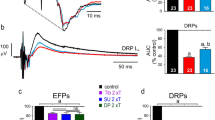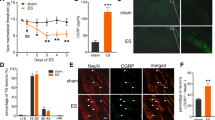Abstract
The aim of the present study was to test the hypothesis that activation of α2-adrenoreceptors modulates the excitability of C1 neurons having convergent inputs from both the tooth pulp (TP) and the superior sagittal sinus (SSS), by using the microiontophoretic techniques of drug application and immunohistochemical approaches. Extracellular single-unit recordings were made from 38 C1 neurons responding to electrical stimulation of TP under pentobarbital-anesthetized rats. Seventy-one percent of C1 neurons (27/38) that responded to TP stimulation also responded to electrical stimulation of the SSS. In these neurons, l-glutamate-evoked C1 neuronal discharge firings were increased in a dose-dependent manner. The mean glutamate-evoked firing rates were dose-dependently inhibited after microiontophoretic application of clonidine (α2-adrenoreceptor/imidazoline I1 receptor agonist). The inhibition of glutamate-evoked C1 mean firings by clonidine was antagonized by the co-application of idazoxan (α2-adrenoreceptor/imidazoline I2 receptor antagonist), yohimbine (α2-adrenoreceptor) but not the α1-adrenoreceptor antagonist, prazosin with affinity for α2B- and α2C-adrenoreceptors. The mean spontaneous discharge frequencies were significantly inhibited by the microiontophoretic application of clonidine and this inhibition was reversed by the co-application of idazoxan, yohimbine. Microiontophoresis of clonidine also resulted in a reduction of TP-/SSS-evoked activity and this effect was reversed by the co-application of yohimbine. Immunoreactivity for α2A-adrenoreceptor was found in the superficial layers of I–III in the C1 region. These results suggest that α2-adrenoreceptor agonist clonidine inhibits the excitability of C1 neurons having convergent inputs from TP and SSS afferents, and that the activation of α2A-adrenoreceptors onto C1 dorsal horn neurons may contribute as a useful therapeutic target for the alleviation of trigeminal referred pain associated with migraine and tooth pain.






Similar content being viewed by others
References
Andres KH, Von During M, Muszynski K, Schmidt RF (1987) Nerve fibres and their terminals of the dura mater encephali of the rat. Anat Embryol 175:289–301
Angus-Leppan H, Olausson B, Boers P, Lambert GA (1994) Convergence of afferents from superior sagittal sinus and tooth pulp on cells in the upper cervical spinal cord of the cat. Neurosci Lett 182:275–278
Anthony M, Lance JW, Somerville B (1972) A comparative trial of pindolol, clonidine and carbamazepine in the interval therapy of migraine. Med J Aust 1:1343–1346
Arvidsson J, Rappana P (1989) An HRP study central projections from primary sensory neurons innervating the rat masseter muscle. Brain Res 480:111–118
Bereiter DA, Bereiter DF (2000) Morphine and NMDA receptor antagonism reduce c-fos expression in spinal trigeminal nucleus produced by acute injury to TMJ region. Pain 85:65–77
Bylund DB, Blaxall HS, Iversen LJ, Caron MG, Lefkowitz RJ, Lomasney JW (1992) Pharmacological characteristics of alpha2-adrenergic receptors: comparison of pharmacologically defined subtypes with subtypes identified by molecular cloning. Mol Pharmacol 42:1–5
Bylund DB, Eikenberg DC, Hieble JP, Lanzer SZ, Lefkowitz RJ, Menneman KP, Molinoff PB, Buffolo RR Jr, Trendelenburg U (1994) International union of pharmacology nomenclature of adrenoceptors. Pharmacol Rev 46:121–136
Cox DH, Dunlap K (1992) Pharmacological discrimination of N-type from L-type calcium current and its selective modulation by transmitters. J Neurosci 12:906–914
Davis KD, Treede RD, Raja SN, Meyer RA, Campbell JN (1991) Topical application of clonidine relieves hyperalgesia in patients with sympathetically maintained pain. Pain 47:309–317
Denaro A, Martucci NA, Ruggieri S, Manna V, Agnoli A (1985) Headache and noradrenergic involvement: the effects of alpha 2 stimulants and alpha 2-antagonists. Acta Psychiatr Scand 320:20–25
Diaz A, Mayet S, Dickenson AH (1997) BU-224 produces spinal antinociception as an agonist at imidazoline I2 receptors. Eur J Pharmacol 333:9–15
Feindel W, Penfield W, Mcnaughton F (1960) The tentorial nerves and localization of intracranial pain in man. Neurolology 10:555–563
Foreman RD (2000) Integration of viscerosomatic sensory inputs at the spinal level. Prog Brain Res 122:209–221
Glynn CJ, Jamous MA, Teddy PJ (1992) Cerebrospinal fluid kinetics of epidural clonidine in man. Pain 49:361–367
Grudt TJ, Williams JT, Travagli RA (1985) Inhibition by 5-hydroxytryptamine and noradrenaline in substantia gelatinosa of guinea-pig spinal trigeminal nucleus. J Physiol (Lond) 485:113–120
Hayes AG, Skingle M, Tyers MB (1986) Alpha-adrenoreceptor-mediated antinociception and sedation in the rat and dog. Neuropharmacology 25:391–396
Hoskin KL, Kaube H, Goadsby PJ (1996) Central activation of the trigeminovascular pathway in the cat is inhibited by dihydroergotamine. A c-fos and electrophysiological study. Brain 119:249–256
Jones SL (1991) Descending noradrenergic influences on pain. Prog Brain Res 88:381–394
Kallaranta T, Hakkarainen H, Hokkanen E, Tuevinen T (1977) Clonidine in migraine prophlaxis. Headache 17:169–172
Kaube H, Keay KA, Hoskins KL, Bandler R, Goadsby PJ (1993) Expression of c-Fos-like immunoreactivity in the caudal medulla and upper cervical spinal cord following stimulation of the superior sagittal sinus in the cat. Brain Res 629:95–102
Keller JT, Marfurt CF (1991) Peptidergic and serotoninergic innervation of the rats dura matter. J Comp Neurol 309:515–534
MacDermott AB, Role LW, Siegelbaum SA (1999) Presynaptic ionotropic receptors and the control of neurotransmitter release. Annu Rev Neurosci 22:443–485
Marfurt CF, Turner DF (1984) The central projections of tooth pulp afferent neurons in the rat as determined by the transganglionic transport of horseradish peroxidase. J Comp Neurol 223:535–547
Matsumoto S, Takeda M, Tanimoto T (1999) Effects of electrical stimulation of the tooth pulp and phrenic nerve fiberson the C1 spinal neurons in the rats. Exp Brain Res 126:351–358
Michel MC, Ernsberger P (1992) Keeping an eye on I-site: imidazoline-preferring receptors. Trends Pharmacol Sci 13:369–370
Michel MC, Brodde OE, Schnepel B, Beharendt J, Tschada R, Motulsky HJ, Insel PA (1989) [3H]-Idazoxan and some other α2-adrenergic drugs also bind with high affinity to a nonadrenergic site. Mol Pharmacol 35:324–330
Millan MJ (2002) Descending control of pain. Prog Neurobiol 663:355–474
Millar J, Williams G (1989) Effects of iontophoresis of noradrenaline and stimulation of the periaqueductal gray on single-unit activity in the rat superficial dorsal horn. J Comp Neurol 287:119–133
Millar J, O’Brien FE, Williams G, Wood J (1993) The effects of iontophoretic clonidine on neurons in the rat superficial dorsal horn. Pain 53:137–145
Nag S, Mokha SS (2004) Estrogen attenuates antinociception produced by stimulation of the Kölliker–Fuse nucleus in the rats. Eur J Neurosci 20:3203–3207
Nishikawa T, Takeda M, Tanimoto T, Matsumoto S (2004) Convergence of nociceptive information from temporomandibular joint and tooth pulp afferents on C1 spinal neurons in the rat. Life Sci 75:1465–1478
North RA, Yoshimura M (1984) The actions of noradrenaline on neurons of the rat substantia gelatinosa in vitro. J Physiol (Lond) 349:43–55
Olave MJ, Maxwell DJ (2003) Neurokinin-1 projection cells in the rat dorsal horn receive synaptic contacts from axons that possess α2C-adrenergic receptors. J Neurosci 23:6837–6846
Peng YB, Lin Q, Willis WD (1996) Involvement of alpha-2 adrenoreceptors in the periaqueductal gray-induced inhibition of dorsal horn cell activity in rats. J Pharmacol Exp Ther 278:125–135
Roudet C, Mouchet P, Feuerstein C, Savasta M (1994) Normal distribution of alpha 2-adrenoreceptors in the rat spinal cord and its modification after noradrenergic denervation: a quatitative autographic study. J Neurosci Res 39:319–329
Storer RJ, Goadsby PJ (1999) Trigeminovascular nociceptive transmission involves N-methyl-D-aspartate and non-N-methyl-D-aspartate glutamate receptors. Neuroscience 90:1371–1376
Sullivan AF, Dashwood MR, Dickenson AH (1987) α2-adrenoreceptor modulation of nocicception in rat spinal cord: location, effects and interaction with morphine. Eur J Pharmacol 138:169–177
Takeda M, Tanimoto T, Matsumoto S (1999) Effects of N-methyl-D-aspartate (NMDA) and non-NMDA receptor antagonists on the tooth pulp-evoked C1 neurons in the rat. Exp Brain Res 128:303–308
Takeda M, Tanimoto T, Matsumoto S (2000) Change in mechanical receptive field properties induced by GABAA receptor activation in the trigeminal spinal nucleus caudalis neurons in rats. Exp Brain Res 134:409–416
Takeda M, Ikeda M, Tanimoto T, Lipski J, Matsumoto S (2002) Changes of the excitability of rat trigeminal root ganglion neurons evoked by α2-adrenoreceptors. Neuroscience 115:731–741
Takeda M, Tanimoto T, Ikeda M, Kadoi J, Nasu M, Matsumoto S (2004) Opioidergic modulation of excitability of rat trigeminal root ganglion neurons projections to superficial layer of cervical dorsal horn. Neuroscience 125:995–1008
Takeda M, Tanimoto T, Ito M, Nasu M, Matsumoto S (2005a) Role of capsaicin sensitive primary afferent fiber input from masseter muscle into C1 spinal neuron responding to tooth-pulp stimulation in rats. Exp Brain Res 160:107–117
Takeda M, Tanimoto T, Ikeda M, Nasu M, Kadoi J, Shima Y, Ohta H, Matsumoto S (2005b) Temporomandibular joint inflammation potentiates the excitability of trigeminal root ganglion neurons innervating facial skin in rats. J Neurophysiol 93:2723–2738
Takeda M, Tanimoto T, Ikeda M, Kadoi J, Nasu M, Matsumoto S (2005c) Activation of NK1 receptor of trigeminal root ganglion via substance P paracrine mechanism contribute to the mechanical allodynia in temporomandibular joint inflammation in rats. Pain 116:375–385
Tanimoto T, Takeda M, Matsumoto S (2002) Suppressive effect of vagal afferents on cervical dorsal horn neurons responding to tooth-pulp electrical stimulation in the rats. Exp Brain Res 145:468–479
Tanimoto T, Takeda M, Nishikawa T, Matsumoto S (2004) The role of 5-hydroxytryptamine 3 receptors in the vagal afferent activation-induced inhibition of the first cervical dorsal horn spinal neurons projected from tooth pulp in the rat. J Pharmacol Exp Ther 311:803–810
Tanimoto T, Takeda M, Nasu M, Kadoi J, Matsumoto S (2005) Immunohistochemical co-expression of carbonic anhydrase II with Kv1.4 and TRPV in rat small diameter trigeminal root ganglion neurons. Brain Res 1044:262–265
Unnerstall JR, Kopajtic TA, Kuhar MJ (1984) Distribution of α2-agonist binding sites in the rat and human central nervous system: analysis of functional, anatomic correlates of the pharmacologic effects of clonidine and related adrenergic agents. Brain Res 319:69–101
Wang X-M, Zhang Z-J, Bains R, Mokha SS (2002) Effect of antisense knock-down α2A- and α2C-adrenoceptorrs on the antinociceptive action of clonidine on the trigeminal nociception in the rat. Pain 98:27–35
Wu L-G, Saggau P (1997) Presynaptic inhibition of elicited neurotransmitter release. TINS 20:204–212
Yeomans DC, Proudfit HK (1992) Antinociception induced by microinjection of substance P into the A7 catecholamine cell group in the rat. Neuroscience 49:681–691
Zhang K-M, Wang X-M, Peterson AM, Chen W-Y, Mokha SS (1998) α2-adrenoceptors modulate NMDA-evoked responses of neurons in superficial and deeper dorsal horn of the medulla. J Neurophysiol 80:2210–2214
Zimmermann M (1983) Ethical guidelines for investigations of experimental pain in conscious animals. Pain 16:109–110
Author information
Authors and Affiliations
Corresponding author
Rights and permissions
About this article
Cite this article
Takeda, M., Tanimoto, T., Takahashi, M. et al. Activation of α2-adrenoreceptors suppresses the excitability of C1 spinal neurons having convergent inputs from tooth pulp and superior sagittal sinus in rats. Exp Brain Res 174, 210–220 (2006). https://doi.org/10.1007/s00221-006-0442-6
Received:
Accepted:
Published:
Issue Date:
DOI: https://doi.org/10.1007/s00221-006-0442-6




